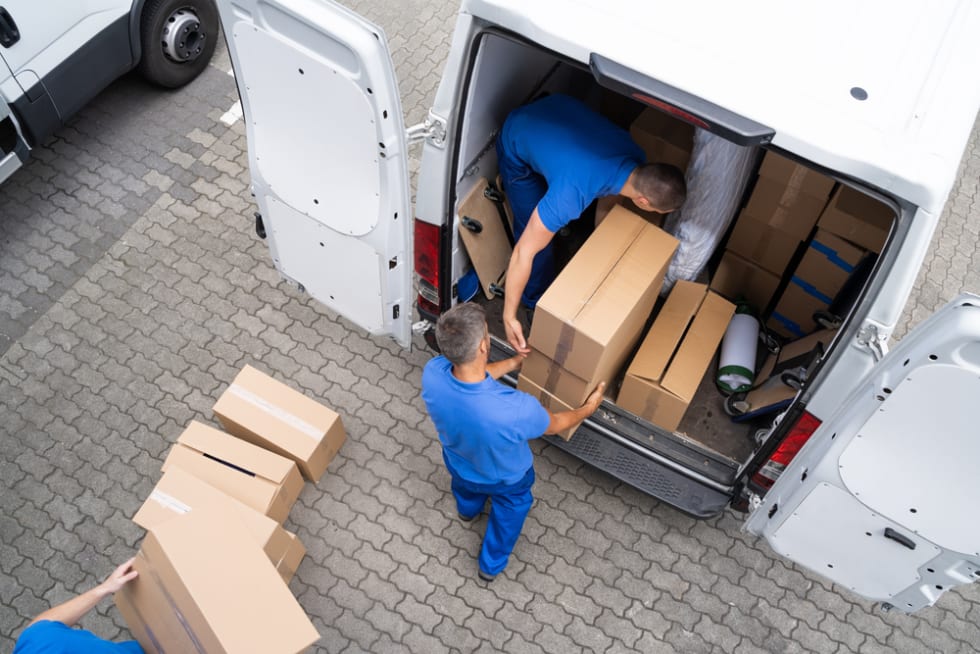How to Move Cross Country

Are you preparing for a cross-country move?
Are you making the move from bustling New York City to laid-back San Francisco? How about transferring from your satellite office in Seattle to the headquarters in Boston?
People move across the country for many reasons. Some accept new job opportunities, while others are just looking for a change of pace or a new adventure. Whatever the reason, all cross-country movers know that though the move itself is exciting, the process can be a little tricky.
This guide will outline all the steps you need to take to get the most out of your cross-country move. Here’s everything you need to know.
1. Planning Your Move
Before you begin the physical act of moving, you’ll have to have a place to move! That means budgeting for your apartment and determining whether your living arrangements will include renting with roommates.
Moving without having a home already picked out can be stressful and costly. If you haven’t yet signed a lease agreement on a new apartment, start your apartment search.
Unfortunately, a cross-country move requires a much more intensive logistics plan than that or an in-state move. Here’s a breakdown of the essential steps to take when moving to another state:
- Narrow down your search. First, consider your new home at a state level. Move down to a city level before ending up at the neighborhood level. This strategy will help you choose a new home that suits your needs.
- If you aren’t able to tour apartments in person before moving, learn how to rent sight unseen. It takes more work than the traditional renting process, but you can still end up with an awesome new apartment in the end.
- If you want to take your time and tour apartments in person, consider finding a furnished month-to-month lease. You’ll have a month (or more, depending on your needs) to find an apartment with a long-term lease agreement that you adore.
Once you’re all set, confirm the earliest move-in date with your new landlord. While the lease may officially begin on a certain date, tenants sometimes move out early, which could give you the opportunity to move in early. You can then figure out how much prep time you need before you leave your old home behind.
2. Consider Downsizing Your Belongings
It’s common to downsize for cross-country moves. When you consider moving costs, packing time, and the sheer amount of things you own, reducing your belongings before moving cross-country is a smart move.
Start by getting measurements and layout of your apartment from the landlord or property manager beforehand. Will your comfy queen-size bed fit into your new room? Do you have space for a dresser, or should you buy under-the-bed storage containers?
Just keep in mind that the more stuff you bring, the more money you’ll spend on moving the belongings. You’ll require a larger rental truck and the service of professional movers to help you transport your large furniture items.
If you’re going to be living with roommates, connect with them to determine what each of you is planning to bring that will be shared. Items for common areas like living room furniture and kitchen utensils can usually be divided up instead of everyone bringing their own (though you can never have too many throw pillows).
Start selling large furniture and other items you don’t need early on. Selling and buying new furniture when you move can be easier and more cost-effective.
If you’re not sure which items to sell and which to keep, consider selling only the items that you would be okay leaving behind.
You can post your wares for sale (or list them for free) on Craigslist or Facebook Marketplace to lighten your load and earn some extra cash to then spend on all new furniture for your new place. It’s a cost-effective moving strategy.
That said, you may not be able to sell all your items. For items you can’t sell, try donating them to avoid adding them to the world’s trash barges. You can donate them to charity resellers like Goodwill or connect with your local charities to put your items to good use.
Pro Tip: The secondhand furniture market has taken a hit due to concerns of bed bugs, especially in fabric items like couches and beds. If possible, rent a steam cleaner from your local Home Depot or Lowes. Take an evening to steam every crevice of your furniture and take pictures of the process. People will be much more likely to buy furniture that they perceive as clean and unlikely to bring an infestation to their homes.

3. Begin the Packing Process
How will you transport your belongings to your new place from your old place? Now is the time to begin thinking about your moving options. Will you be driving yourself, using a rental truck, scheduling shipping services like PODS, or something else?
Regardless of which moving option you choose, you’ll need to get all your items securely packaged up and prepared for the move.
Once you’ve sold off your big-ticket items, it’s time to determine what belongings you want to have in your new home. We recommend a good old-fashioned list very early on because packing can take a while.
Okay, while it’s not exactly old-fashioned, a digital list can help you make the process much more efficient, organized, and manageable. Not to mention, shareable lists with real-time updates (yes, you packed your coffee maker) can make packing with a partner or loved one much easier.
Start by listing out your must-have items. These items will include things like your favorite cookware or your antique bed frame. They’ll be the things you don’t want to replace. Once you’ve got your essentials listed, choose the items you want to bring but could live without.
After you box up all of your necessities, you’ll have a better idea of what else you can fit and can continue boxing until there isn’t any space left. Any leftover items can join the ones you have already posted for sale or have been set to join the donations bin.
If you need to pick up packing supplies, check in with local businesses such as grocery and liquor stores, as they tend to have free boxes, bubble wrap, and newspaper laying around.
4. Arranging Transportation
Let’s get something out of the way first. Unless you are an ultra-minimalist, you’ll have to enlist the help of professional moving companies or services to get your belongings across the country.
While getting yourself to your destination by flying or taking a bus is relatively simple to figure out, transporting your assets can be challenging. If you’re moving for a new job and your company provides relocation assistance, you should definitely take advantage of it.
If you’re on your own, you should look into long-distance moving services. There are two primary types of services in this field: movers and containers.
Professional movers provide full-service moving options. They will handle the loading, transportation, and unloading of your belongings during your move. You’ll still have to pack and unpack, but for the most part, this is a hands-off process that you simply get to oversee.
Moving container services allow you to rent a container and arrange for its transportation to your new home. You’re responsible for packing, unpacking, loading, and unloading all your belongings. It’s a little more work on your end but typically costs less than full-service movers.
As a container can be dropped off at your current home and picked up when you request, you’ll have some flexibility as to when you start and finish packing.
As professional movers get the job done from start to finish, they’re relatively easy to get sorted. Start by researching local, long-distance moving companies and getting quotes from each.
Take time to compare reviews and choose a company that seems like the best fit for you. They’ll walk you through the process and help you ensure that the move goes smoothly.
5. Rent from a Moving Container Service
When it comes to getting your things from point A to point B, renting a moving container is the best option for the dedicated DIYer.
To begin the straightforward rental process, collect quotes from the providers that service your area. The list might be relatively short. The moving container industry isn’t exactly oversaturated at the moment.
You’ll likely end up choosing between a company like PODS or another major moving company’s container services. Regardless of which company you choose, you’ll need to consider cost and reputation.
While PODS has a fantastic reputation and a grip on the moving container industry, your decision about whether they’re the best option for you may come down to the cost of PODS.
While a moving container service may cost more than a traditional DIY move with a trailer rental, it can offer substantial convenience.
Moving container rentals include the scheduled pick-up and drop-off of your belongings from your current home to your new home in a new state. When all you’re responsible for doing is scheduling and loading your belongings, getting your stuff to your new home falls into the “easy peasy” category.

6. Rent a Moving Truck
It’s easy to see the appeal of renting a moving truck for your cross-country move. You have to get yourself and your belongings to your new place. Why not do both at the same time?
However, if you choose to opt for a moving truck over a moving container service, you may end up saving money on the deal but losing out on some of the convenience. When you rent a moving truck, you sign yourself up to load, unload, and transport your stuff from your old home to your new one.
That’s a lot of work, no matter how you slice it. That said, renting a moving truck is a wildly popular option. As a potential side effect of the increased remote work opportunities, many people are making similar cross-country moves using rental trucks.
The downside of its popularity is that you’ll likely have a lot of competition when it comes to booking your truck. Try to book your rental as early as possible. You’ll avoid availability issues this way, as moving trucks are going quickly.
Depending on the timing of your move, you may be able to avoid current high truck rental rates. Regardless, it’s important to get quotes from reputable rental truck companies to ensure that your budget is able to accommodate these costs.
If you have a sizable moving budget, you could also consider booking local movers or TaskRabbit contractors to help get your stuff loaded and unloaded. This will boost the convenience factor of using a rental truck for your cross-country move.
7. Plan the Trip
Although flying is an option, it’s not always the most efficient one when you’re moving cross-country. For one, most people choose to bring their cars along for their cross-country moves. If you’re moving with a pet, flying can be a stressful, frightening experience.
All-in-all, If you want to bring your car to your new city or would prefer to transport your possessions without the help of a service, driving cross-country is definitely the best option for your long-distance move.
If you don’t have your own car to bring but still would like to drive, check out one-way truck rental companies like Budget Truck and UHaul. If you are driving your own car but don’t have space for your abundance of belongings in your back seat, you can also rent a tow trailer from UHaul.
When budgeting for these trucks, don’t forget to consider gas. Filling up a moving truck is expensive, and the trucks don’t exactly have incredible gas mileage. Be sure to ask about the typical gas cost when filling up the moving truck to get an estimate accurate before you fill up for the first time.
That said, you can’t expect to complete the road trip in a single day, so you’ll have to map out your journey. Instead of doing it yourself, we recommend using sites like Roadtrippers and Furkot.
Start by entering your destination and the number of hours you’d like to spend driving per day. If you are moving with pets, plan for stops along the way so they can stretch their legs and take potty breaks. This can add a little extra time to your drive, but not distance, so be sure to account for that before submitting your information.
After you submit your information, the platforms will determine where you should book a hotel each night based on location approximation. If you want to save money and avoid booking a traditional hotel, give motels, Airbnb, or Couchsurfing a try.
If you’ll be parking a large moving truck overnight, look for a safe neighborhood with a driveway or garage to avoid attracting thieves who may be looking for an opportunity to steal valuables.
That said, moving cross-country is a big deal! Your road trip should be fun.
Do what you can to make the most of the situation. Take as much time as you can to make stops at cool spots along the way. Treat yourself to some of the country’s greatest cuisine. Think of your cross-country drive as the world’s best road trip!

8. Moving In & Settling In
You and your belongings have arrived at your new home in one piece! Congratulations!
After that brief moment of satisfaction for having successfully completed the bulk of your cross-country move, the real work begins.
You’ll need to get your belongings unpacked and settle into your new home.
Clear your schedule for the following day or two. Getting your new home in order will take plenty of time, especially if you broke down furniture and need to put things back together.
The entire process will likely be at least a week, if not more. Between getting accustomed to your new city and running around purchasing all your necessities, the settling-in process can be a lot to handle.
Visualize where everything will go and get each room settled on by one. We recommend starting with the bathroom first (for obvious reasons).
If you want to ease your responsibilities a bit, consider hiring local movers and TaskRabbits. Just be aware that they will generally only handle moving large items into place.
9. Update Your Address
Ideally, you want to get your address changed at least a week prior to your move. Traditional mail typically takes up to four business days to get to you. Changing things a week in advance allows you to retrieve any wayward packages and mail that you may have missed otherwise. It also gives mail services time to apply the change to incoming mail.
That said, you’ll have to update your address across multiple entities. Here are some of the most common places you’ll need to change your address.
- USPS Change of Address: Lastly, don't forget to update your address with USPS. It only takes a few minutes and $1 out of your bank account.
- If Keeping the Same Job, Update Address with HR: You’ll need to get this handled for tax purposes, so don’t forget it!
- Banking: This will change the billing address for your accounts and keep things accurate. You’ll likely be able to do this through your bank’s online portal.
- DMV: You won’t have to update your information until you have completed your cross-country trip. However, once you’ve made your move, you’ll need to get your vehicle’s license plates, your driver’s license, and your ID (if applicable) updated.
Final Thoughts
Learning how to move across the country is one skill that you have to learn through practice. As daunting as that may seem, with the right tools and strategies in place (for example, the ones in this guide!), your cross-country move can be a relatively painless process.
It all starts with finding the right home, one that makes a cross-country move well worth the effort. Wherever that may be for you, we’ve got you covered.
Share this Article


